OLDSMOBILE AURORA 1996 User Guide
Manufacturer: OLDSMOBILE, Model Year: 1996, Model line: AURORA, Model: OLDSMOBILE AURORA 1996Pages: 388, PDF Size: 20.24 MB
Page 11 of 388
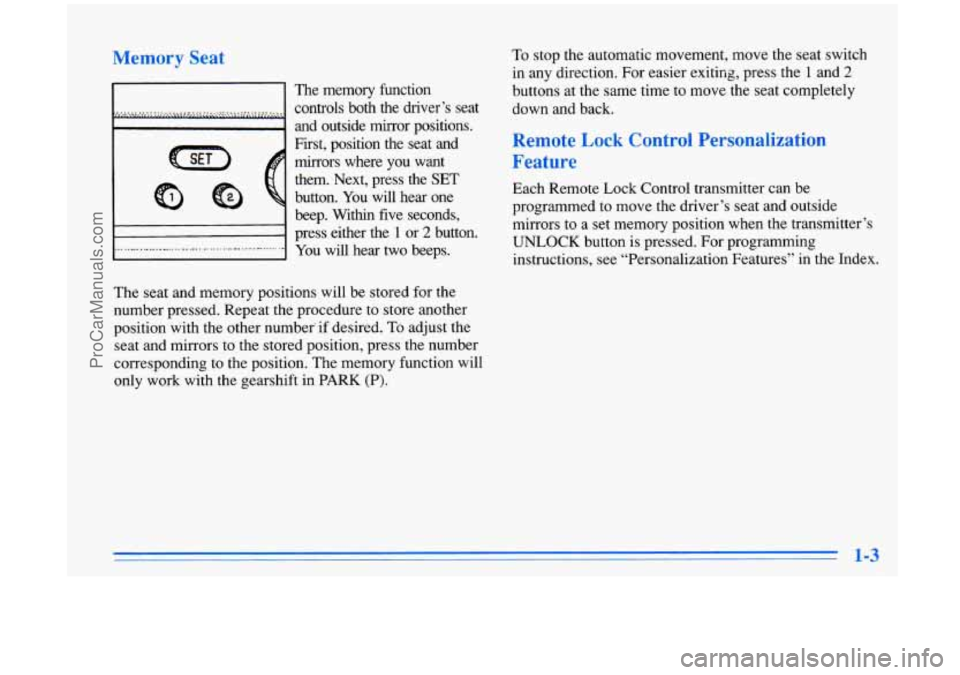
Memory Seat
11 The memory function
................... __ .......................... controls both the driver’s seat
and outside mirror positions.
CE)
First, position the seat and
mirrors where you want
them. Next, press the SET
button. You will hear one
beep. Within five seconds,
11 prek either the 1 or 2 button.
............................................ - ....... I You will hear two beeps.
The seat and memory positions will be stored for the
number pressed. Repeat the procedure to store another
position with the other number’if desired.
To adjust the
seat and mirrors to the stored position, press the number
corresponding to the position. The memory function will
only work with the gearshift in PARK
(P).
To stop the automatic movement, move the seat switch
in any direction. For easier exiting, press the
1 and 2
buttons at the same time to move the seat completely
down
and back.
Remote Lock Control Personalization
Feature
Each Remote Lock Control transmitter can be
programmed to move the driver’s seat and outside
mirrors to a set memory position when the transmitter’s
UNLOCK button is pressed. For programming
instructions, see “Personalization Features” in the Index.
ProCarManuals.com
Page 12 of 388
![OLDSMOBILE AURORA 1996 User Guide Heated Fro] seat (Option) Reclining Front Seatbacks
This feature will quickly heat the lower cushions and
lower back of the driver and front passenger seats for
added comfort.
Press OLDSMOBILE AURORA 1996 User Guide Heated Fro] seat (Option) Reclining Front Seatbacks
This feature will quickly heat the lower cushions and
lower back of the driver and front passenger seats for
added comfort.
Press](/img/31/58193/w960_58193-11.png)
Heated Fro] seat (Option) Reclining Front Seatbacks
This feature will quickly heat the lower cushions and
lower back of the driver and front passenger seats for
added comfort.
Press the button once
to turn the heater on high. The HI
indicator light below the button will glow. Press it again
to turn the heater on low. The
LO indicator light below
the button will glow. Press
it a third time to turn the
heater
off. The heater will turn off automatically when
the ignition is turned off. The
vertical control described previously in this section
reclines the front seatbacks.
But don’t have a seatback reclined
if your vehicle
is moving.
ProCarManuals.com
Page 13 of 388
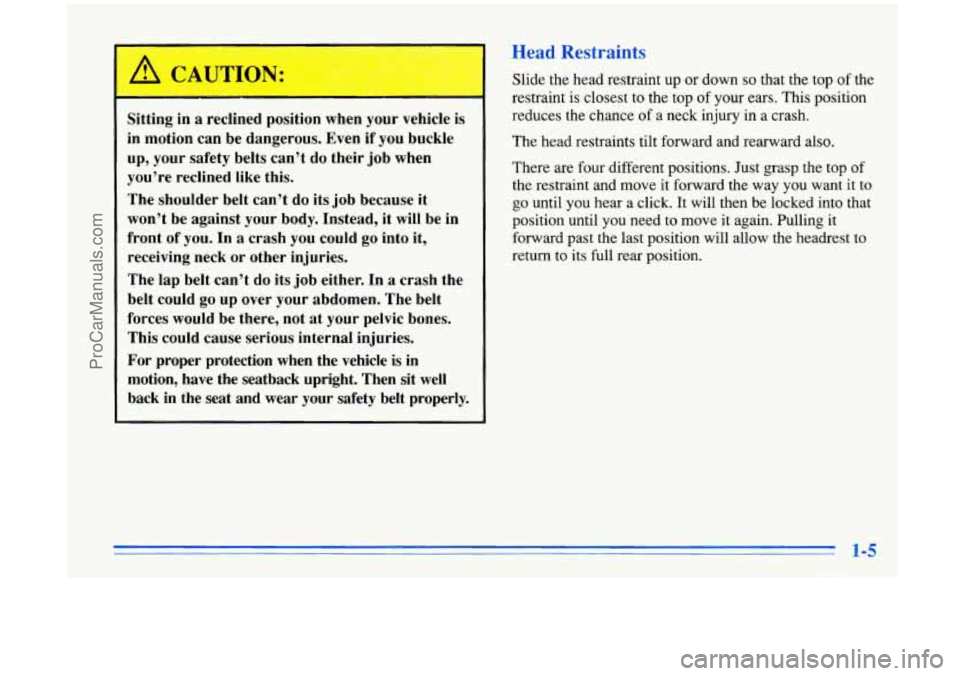
Sitting in a reclined position when your vehicle is
in motion can be dangerous. Even if you buckle
up, your safety belts can’t do their
job when
you’re reclined like this.
The shoulder belt can’t do its job because it
won’t be against your body. Instead, it will be in
front of you. In
a crash you could go into it,
receiving neck or other injuries.
The lap belt can’t do its job either. In a crash the
belt could
go up over your abdomen. The belt
forces would be there, not at your pelvic bones.
This could cause serious internal injuries.
For proper protection when the vehicle is in
motion, have the seatback upright. Then sit well
back in the seat and wear your safety belt properly. Slide
the head restraint up or down
so that the top of the
restraint is closest to the top
of your ears. This position
reduces the chance
of a neck injury in a crash.
The head restraints tilt forward and rearward also.
There are four different positions. Just grasp the top
of
the restraint and move it forward the way you want it to
go until you hear a click. It will then be locked into that
position until you need
to move it again. Pulling it
forward past the last position will allow the headrest to
return to its full rear position.
ProCarManuals.com
Page 14 of 388
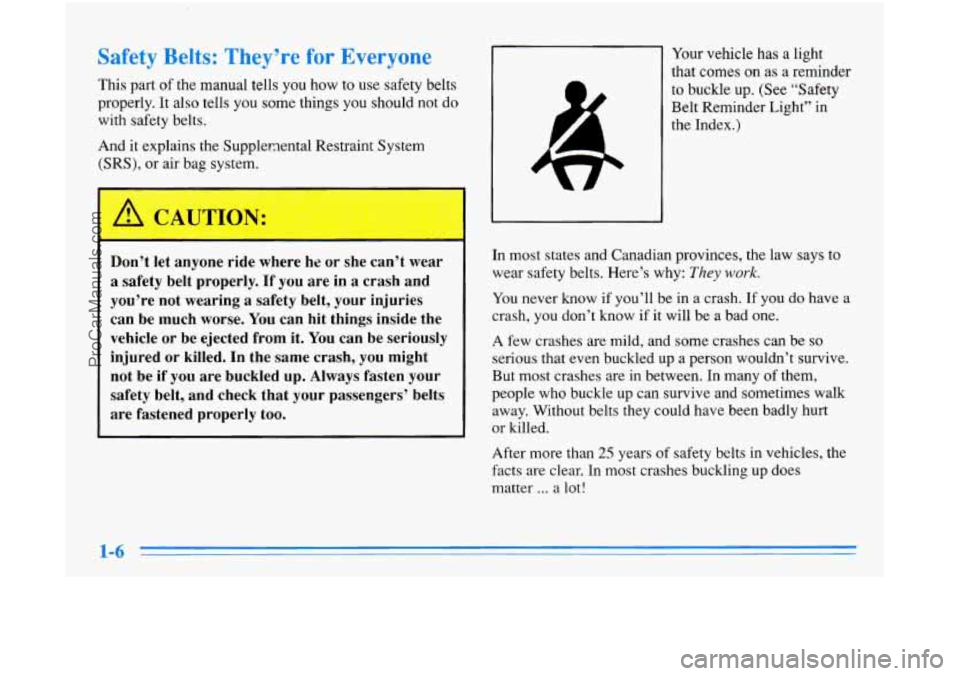
Safety Belts: 7- rey’re ror LVC
This part of the manual tells you how to use safety belts
properly. It also tells you some things you should not do
with safety belts.
And
it explains the Supplemental Restraint System
(SRS), or air bag system.
Don’t let anyone ride where he or she can’t wear
a safety belt properly.
If you are in a crash and
you’re not wearing
a safety belt, your injuries
can be much worse.
You can hit things inside the
vehicle or be ejected from it.
You can be seriously
injured or killed. In the same crash, you might
not be if you are buckled
up. Always fasten your
safety belt,
and check that your passengers’ belts
are fastened properly too. Your
vehicle has a light
that
comes on as a reminder
to buckle up. (See “Safety
Belt Reminder Light” in
the Index.)
In most states and Canadian provinces,
the law says to
wear safety belts. Here’s
why: They work.
You never know if you’ll be in a crash. If you do have a
crash, you don’t know if it will be
a bad one.
A few crashes are mild, and some crashes can be so
serious that even buckled up a person wouldn’t survive.
But most crashes are in between. In many of them,
people who buckle up can survive and sometimes walk
away. Without belts they could have been badly hurt
or killed.
After more than
25 years of safety belts in vehicles, the
facts
are clear. In most crashes buckling up does
matter
... a lot!
ProCarManuals.com
Page 15 of 388

rrhy Sill1
When you ride in or on anything, you go as fast as
it goes.
I
Put someone on it.
Take the simplest vehicle. Suppose it’s just a seat
on wheels.
1-7
ProCarManuals.com
Page 16 of 388

I
Get it up to speed. Then stop the vehicle. The rider
doesn’t stop. The
person keeps going until stopped by something.
In a real vehicle, it could be the windshield
...
ProCarManuals.com
Page 17 of 388

or the instrument panel ... or the safety belts!
With safety belts, you slow down
as the vehicle does.
You get more time to stop. You stop over more distance,
and your strongest bones take the forces. That’s why
safety belts make such good sense.
ProCarManuals.com
Page 18 of 388

Here Are Questions Many People Ask
About Safety Belts -- and the Answers
Q: Won’t I be trapped in the vehicle after an
accident if I’m wearing a safety belt?
A: You could be -- whether you’re wearing a safety
belt
or not. But you can unbuckle a safety belt,
even
if you’re upside down. And your chance of
being conscious during and after an accident, so
you
can unbuckle and get out, is much greater if
you are belted.
@ If my vehicle has air bags, why should I have to
A: Air bags are in many vehicles today and will
be in
most of them in the future. But they are
supplemental systems only;
so they work with
safety belts -- not instead of them. Every air bag
system ever offered for sale has required the use
of
safety belts. Even if you’re in a vehicle that has air
bags, you still have to buckle up
to get the most
protection. That’s true not only in frontal collisions,
but especially in side and other collisions.
wear safety belts?
Q: If I’m a good driver, and I never drive far from
A: You may be an excellent driver, but if you’re in an
home, why should I wear safety belts?
accident -- even one that isn’t your fault -- you and
your passengers can be hurt. Being a good driver
doesn’t protect you from things beyond your
control, such as bad drivers.
Most accidents occur within
25 miles (40 km) of
home. And the greatest number of serious injuries
and deaths occur at speeds of less than
40 mph
(65 hh).
Safety belts are for everyone.
1-10
ProCarManuals.com
Page 19 of 388
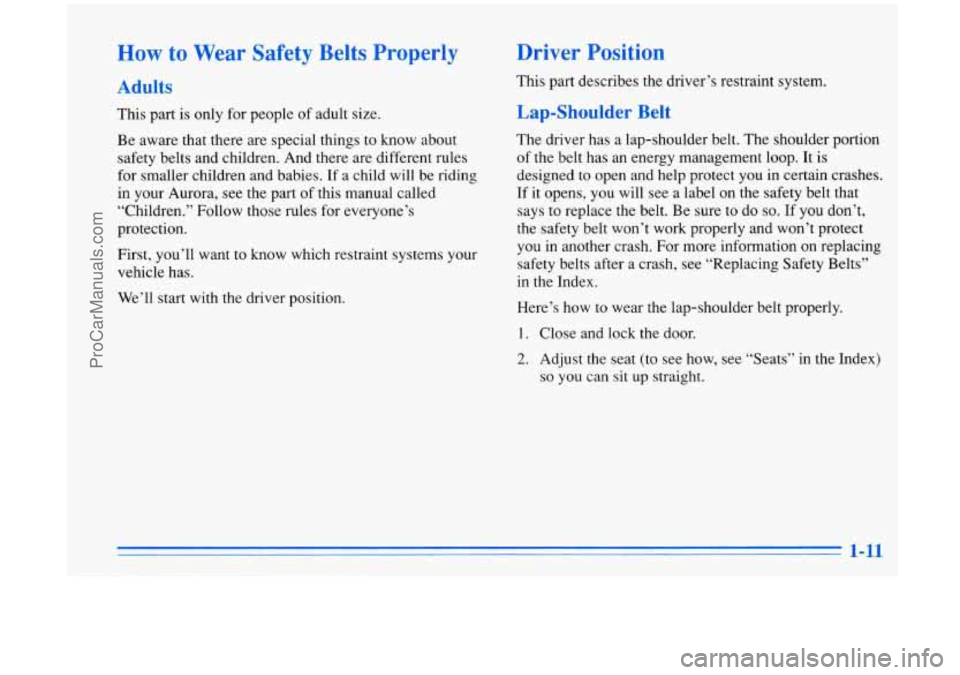
How to Wear Safety Belts Properly
Adults
This part is only for people of adult size.
Be aware that there are special things
to know about
safety belts and children. And there are different rules
for smaller children and babies. If a child will be riding
in your Aurora, see the part of this manual called
“Children.” Follow those rules for everyone’s
protection.
First, you’ll want to know which restraint systems your
vehicle has.
We’ll start with the driver position.
Driver Position
This part describes the driver’s restraint system.
Lap-Shoulder Belt
The driver has a lap-shoulder belt. The shoulder portion
of the belt has an energy management loop. It is
designed to open and help protect you in certain crashes.
If
it opens, you will see a label on the safety belt that
says to replace the belt. Be sure to do
so. If you don’t,
the safety belt won’t work properly and won’t protect
you in another crash. For more information
on replacing
safety belts after a crash, see “Replacing Safety Belts”
in the Index.
Here’s how to wear the lap-shoulder belt properly.
1. Close and lock the door.
2. Adjust the seat (to see how, see “Seats” in the Index)
so you can sit up straight.
ProCarManuals.com
Page 20 of 388
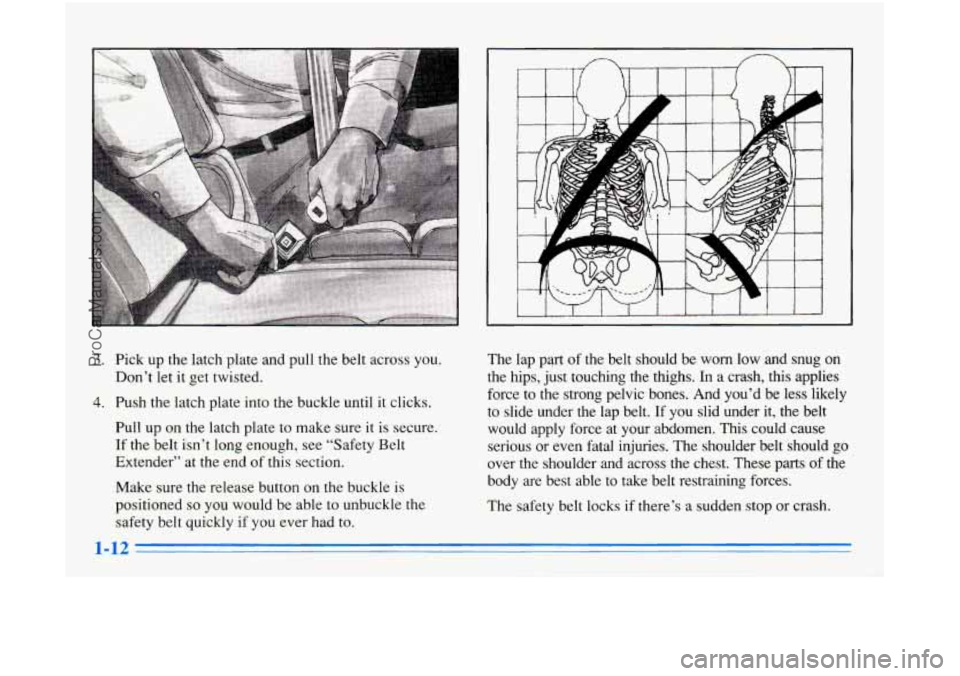
3. Pick up the latch plate and pull the belt across you.
4. Push the latch plate into the buckle until it clicks.
Pull up on
the latch plate to make sure it is secure.
If the belt isn’t long enough, see “Safety Belt
Extender” at
the end of this section.
Make sure the release button on the buckle
is
positioned so you would be able to unbuckle the
safety belt quickly
if you ever had to.
Don’t let
it get twisted. The lap part
of the belt should
be worn low and snug on
the hips, just touching the thighs.
In a crash, this applies
force to the strong pelvic bones.
And you’d be less likely
to slide under the lap belt. If you slid under
it, the belt
would apply force at your abdomen. This could cause
serious or even fatal injuries. The shoulder belt should go
over the shoulder and across the chest. These parts of the
body are best able to take belt restraining forces.
The safety belt locks if there’s a sudden stop or crash.
ProCarManuals.com